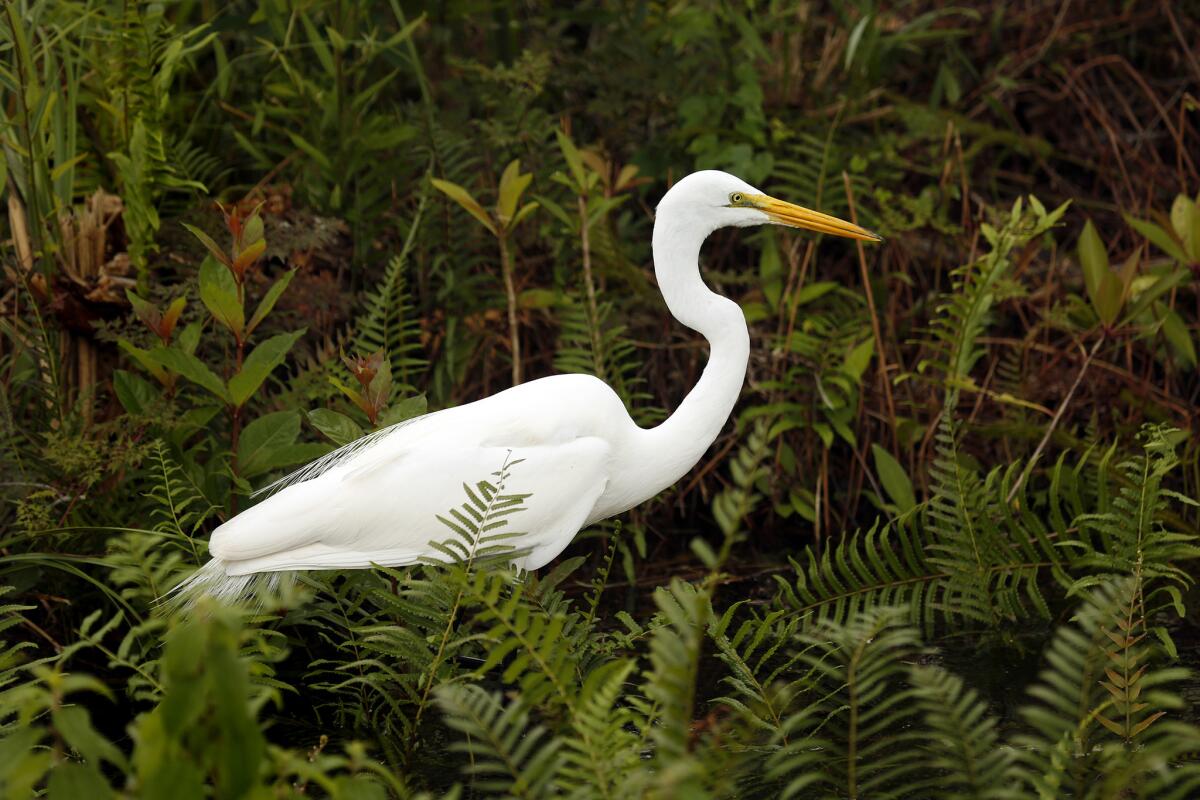In the Everglades, birds nest near alligators for safety. But what’s in it for the gators?
- Share via
Birds choose the safest trees to build their nests. In the Florida Everglades, that means living directly above alligator-infested water.
If that sounds like a perilous choice, consider this: Egrets, heron and other long-legged wading birds of the Florida swamps have more reasons to fear raccoons and possums, who invade nests and eat the birds’ eggs.
That’s where the gators come in.
See the most-read stories in Science this hour >>
The presence of the fearsome reptiles scares away nest-raiding mammals. Without that deterrent, the birds would have no other defense against the furry predators.
But this doesn’t necessarily mean the enemy of one’s enemy is a friend. The birds make sure to build their nests about five feet above the water, where the gators can’t jump up and eat them.

Wading birds like this great white heron use alligators for protection against nest-raiding raccoons and opossums.
“I kind of liken it to less of a bodyguard and more of keeping a psychopath in your yard to keep out the cat burglars,” said ecologist Lucas Nell, who studied the bird-crocodilian relationship while earning his master’s degree at the University of Florida.
Wading birds know that where there are alligators, there are no raccoons. In a 2011 experiment from the University of Florida, researchers found that the birds even preferred to nest above fake alligators.
“Raccoons are devastating for birds,” said Nell, now a research technician at the University of Georgia. “If even a few or a handful of raccoons get into a nest or colony, the birds abandon their nests en masse.… And the raccoons just eat everything.”
But this isn’t a story of clever birds taking advantage of their crocodilian neighbors. It’s more a protection racket playing out in the animal kingdom. The alligators’ protection isn’t free.
Now Nell has figured out why the alligators let the birds stick around: They provide a steady source of food in the form of their chicks, according to a report this week in the journal PLOS ONE.
Wading birds form huge nesting colonies with multiple species and hundreds to thousands of individuals. The birds lay more eggs than the colony can support, so they regularly “eject” one or two chicks from the nest depending on the availability of food that season.
Those chicks go straight to the gators.
The bird colonies also support lower rungs of the food chain. Bird droppings, fallen regurgitated food and general bird waste support plant and algae growth in the marsh below – which get eaten by aquatic invertebrates and small fish, which get eaten by alligators.
For the study, Nell wanted to see if alligators reaped any quality of life rewards from living near a bird colony.
To do that, he and his colleagues needed to catch some gators.
During nighttime airboat outings, the team members caught 39 adult female alligators and measured the reptiles’ body mass and snouts. (The researchers used snout length as a proxy for total length because many alligators are missing bits of the ends of their tails).
The study found a clear disparity: alligators living within 200 meters of bird colonies were significantly healthier than those without avian neighbors.
A typical 6-foot alligator living near a bird colony weighed 6 pounds more than one living more than a kilometer away, Nell said.
A restoration plan for the Everglades sets forth a target for alligator body condition, similar to the body mass index used to assess health in humans. By this measure, the alligators living near bird colonies were very close to meeting conservation goals, but alligators that didn’t fell well below the criteria.
While the American alligator species is found throughout the southeastern United States, life is particularly harsh in Florida’s Everglades, the southernmost tip of the reptiles’ range.
The marshes there don’t provide much in the way of gator food, so the reptiles mainly live off snakes, salamanders, crayfish and other small critters. “They don’t get an opportunity for big meals,” Nell said.
For this reason, the Everglades’ alligators are known to be particularly small for their species.
The study shows that the bird colonies might provide enough food to offset some of the environmental pressures on alligators.
Wading birds tend to nest in trees over deeper water, but that’s not exactly preferable for their protectors.
Other studies have found alligators fare better during dry seasons, when their prey is concentrated in smaller areas and is easier to catch. When water levels are higher, prey animals spread out over a larger area.
The study found the alligators were still healthier near the bird colonies, despite those areas having deeper water. Without the colonies present, the researchers would have expected the alligators to be smaller, he said.
Still, the bird-alligator relationship is by no means harmonious, Nell said.
Captive alligators have been observed to slap at trees with their tails to knock the birds out. “If they’re in range, they’re going to get eaten,” he said.
While further research is needed in other habitats, the study suggests similar interactions between birds and their crocodilian neighbors could exist in other wetlands around the world.
Follow me on Twitter @seangreene89 and “like” Los Angeles Times Science & Health on Facebook.
MORE SCIENCE NEWS
To sleep, perchance to dream, in an increasingly bright world
A tale of two astronauts: Scott and Mark Kelly begin new phase of NASA Twins Study
Angry, easily frustrated young adult? Middle age may bring problems of memory and planning




